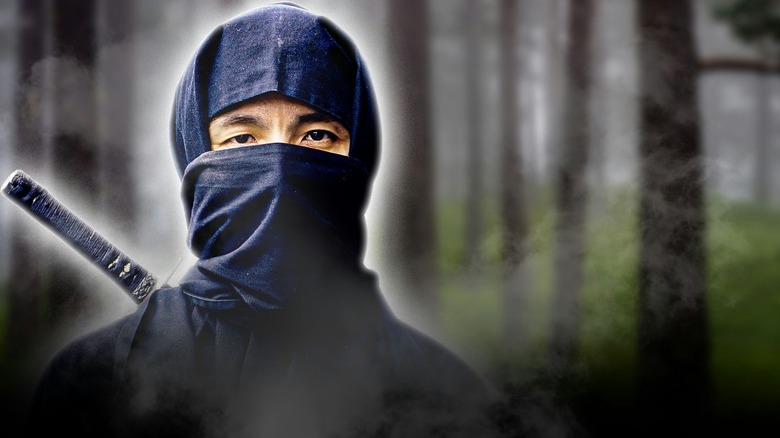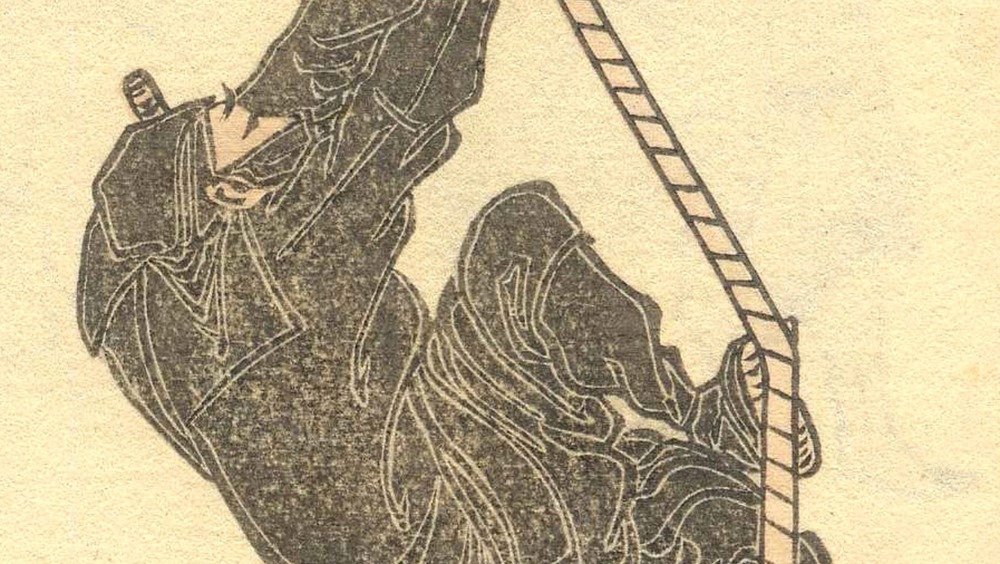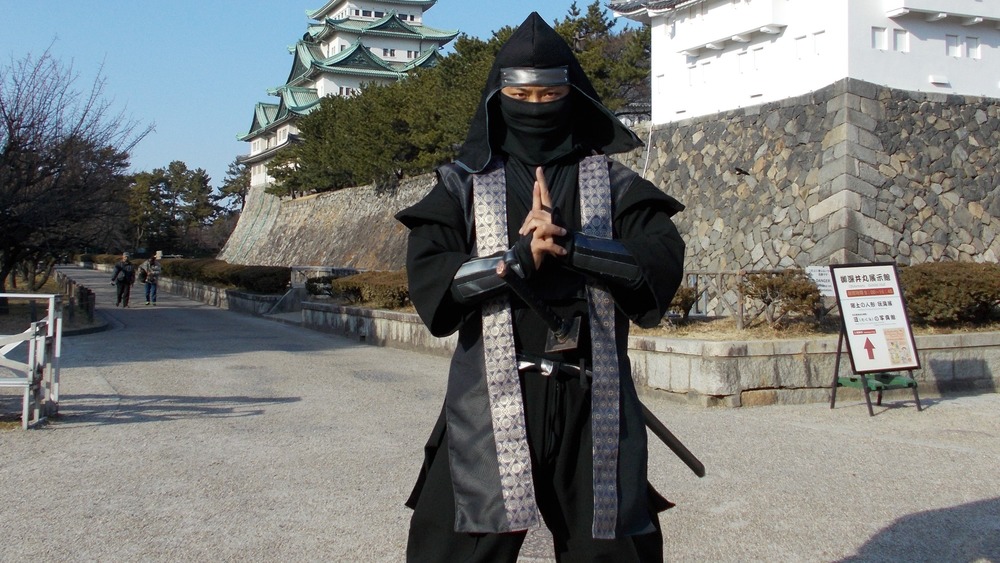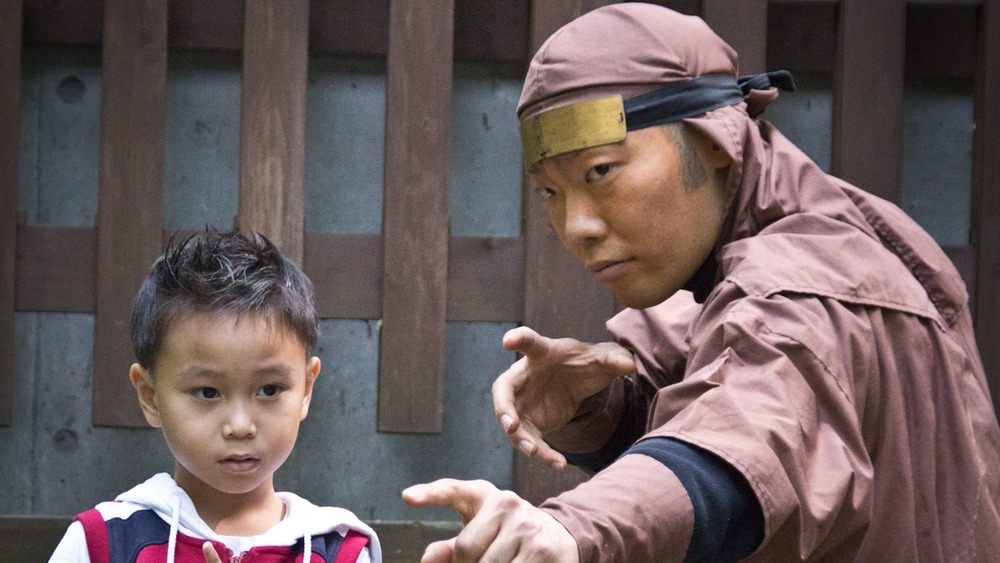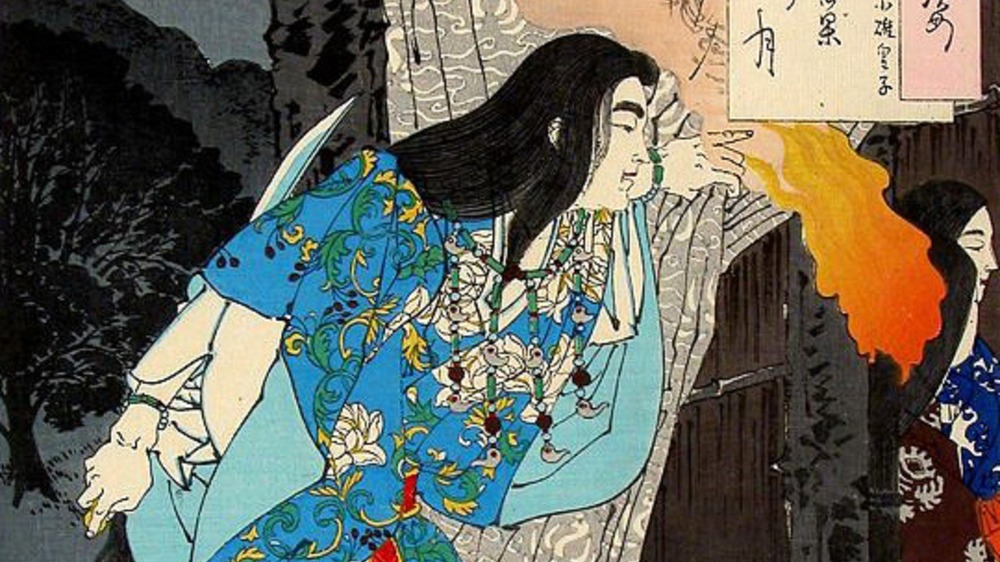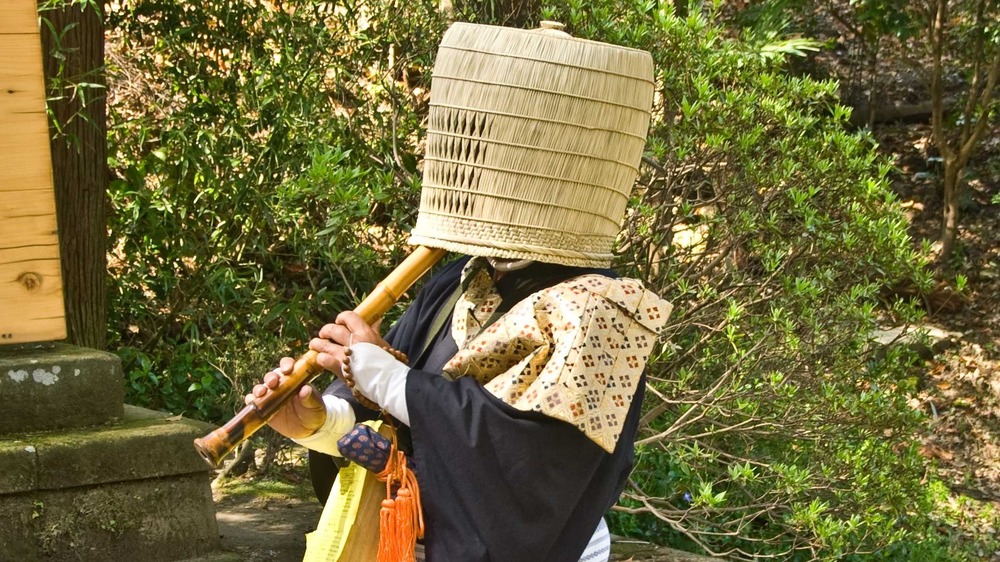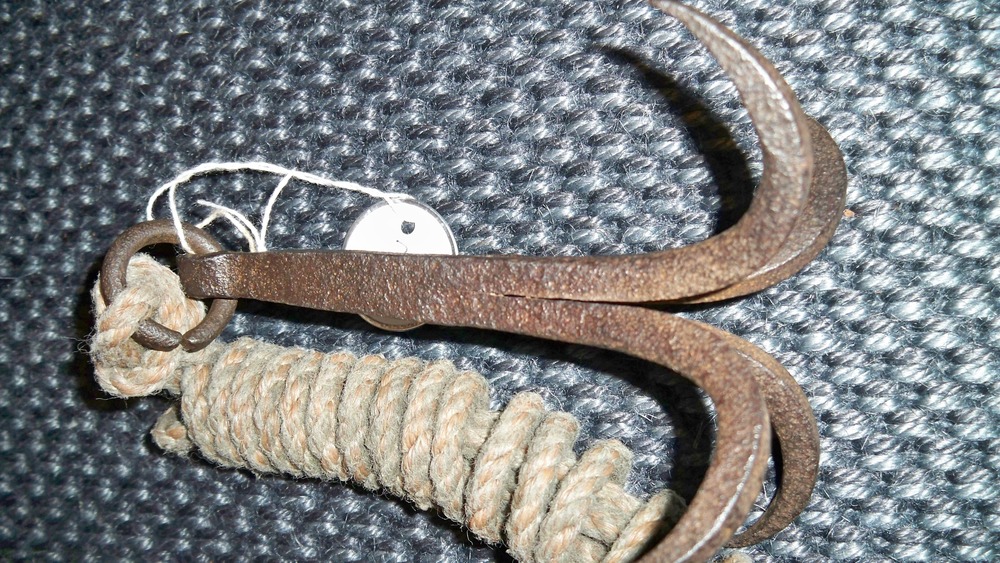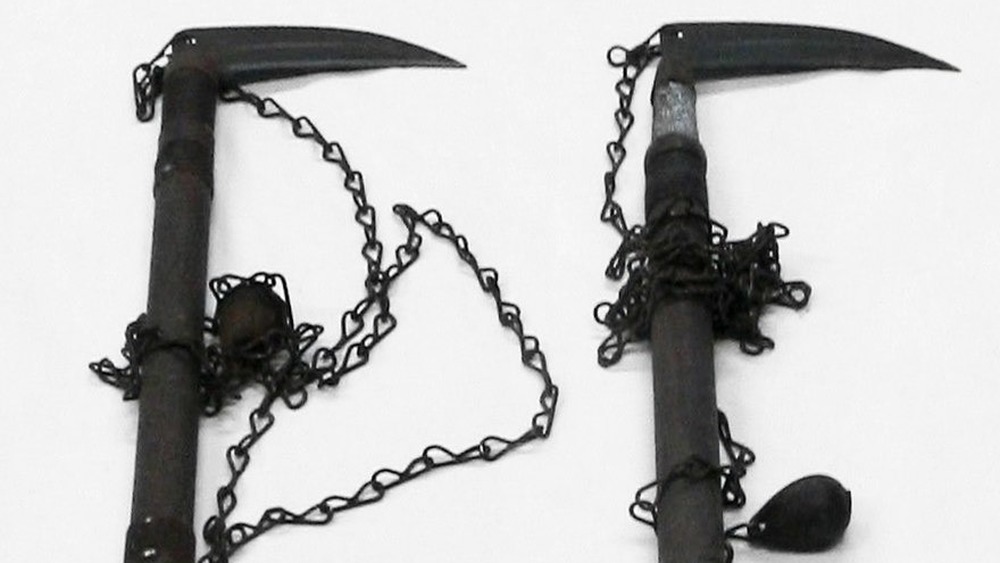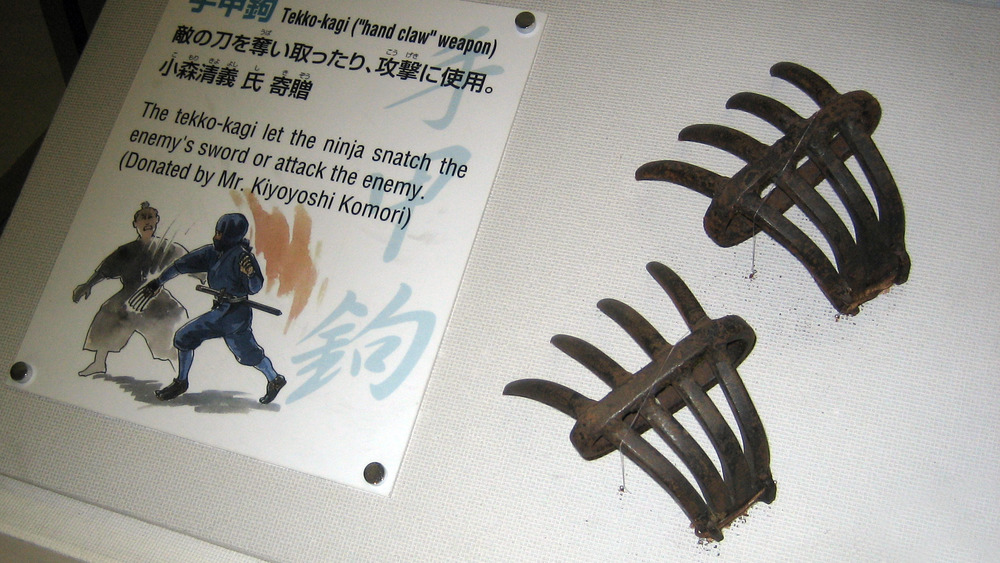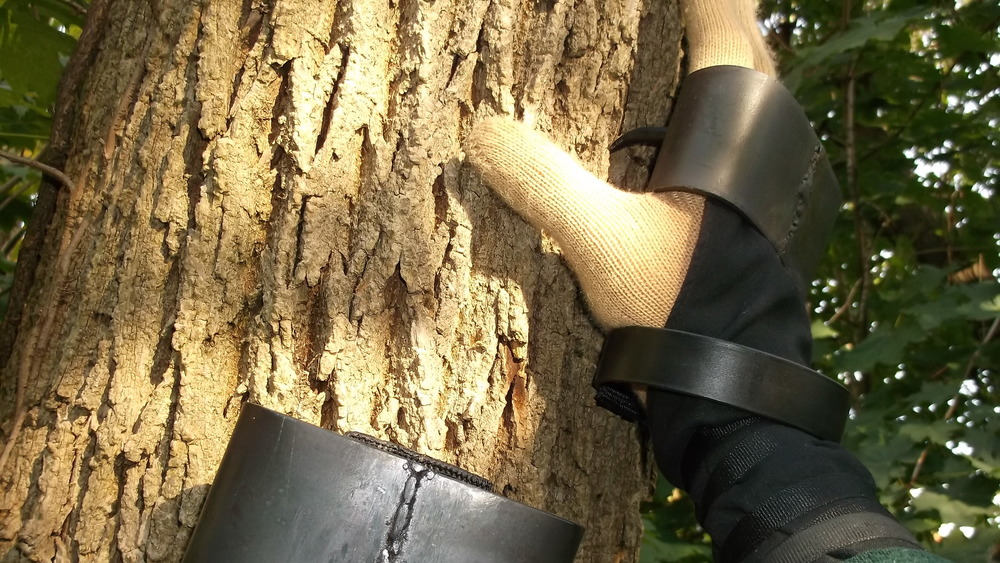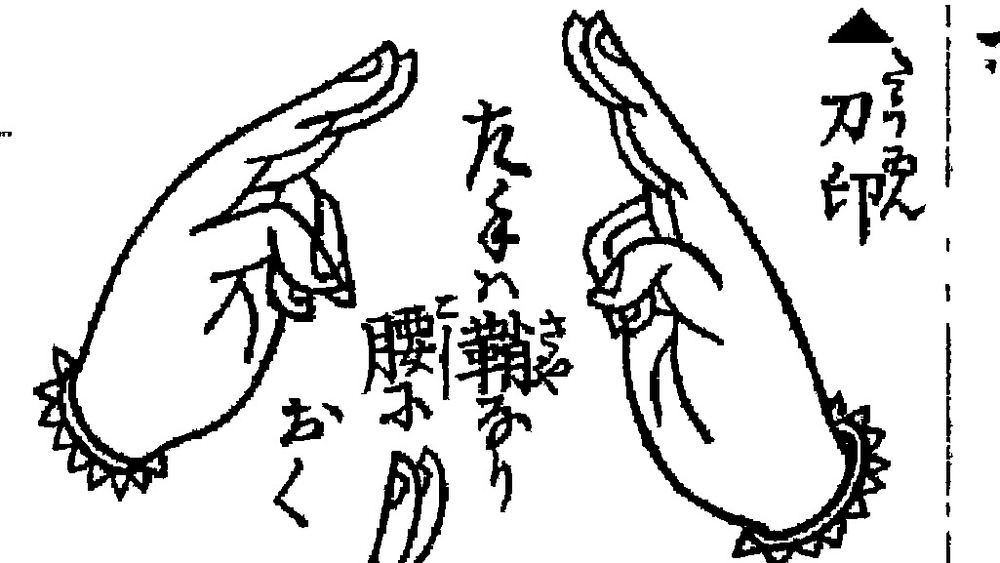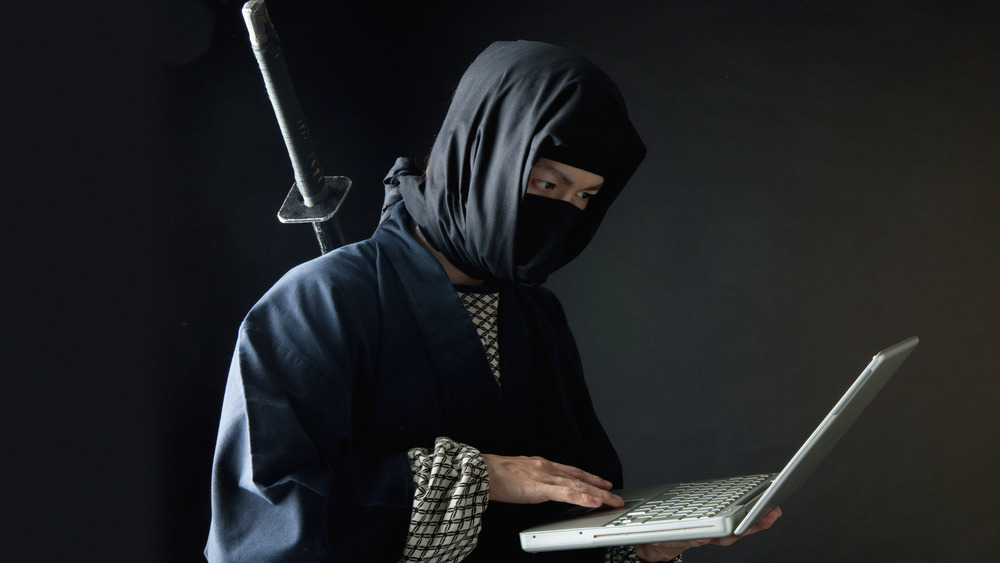Rules Every Ninja Has To Follow
The legend of Japan's black-clad, skulking shinobi no mono, better known as the ninja, is famous in popular culture. But the historical truth of the ninja, as pointed out by the World History Encyclopedia, has been subject to exaggeration if not outright hyperbole. Common tropes include ninjas performing superhuman feats, vanishing in puffs of smoke, and wielding dark magic to destroy their targets. Much of what is known of ninjas comes through oral tradition or accounts written after their heyday in the 15th and 16th centuries. These stories through ever more fanciful retellings constructed the legend of this master class of assassins, spies, and saboteurs. Even the traditional black-hooded uniform that is instantly thought of when one hears the word ninja is an imaginative fabrication of 19th century art.
Still, ninjas were not imaginary. They were medieval Japan's equivalent of special forces much like the SEALS or Green Berets. Ninjas used cutting edge technology and were completely goal oriented. To achieve the kind of success that made ninjas into legend, they had to follow certain rules and requirements of their trade.
Ninjas must make money
Historically, ninjas were mercenaries who had to make money. Alan Axelrod in his book, Mercenaries, discusses how ninjas were the only soldiers for hire in feudal Japan. Ninjas were recruited for jobs primarily focusing on espionage, assassination, reconnaissance, and as fifth columnists. They were also hired for infiltration of enemy fortifications and sabotage. Ninjas could be retained for individual missions or a military campaign. In this last case, ninjas were valued for their ability to act as covert operators to disrupt enemy encampments and act as surprise shock troops.
Ninjas, because of their covert activities, often elicited distrust, including from their employers. For the ninja, loyalty to an employer was behind their own trust in family, community, and teachers.
So how much did ninjas get paid? Not that much, apparently. According to Business Insider, ninjas in feudal Japan made an inflation adjusted $8,000 to $17,000 a year, though it is unclear how this was calculated. Today, however, ninjas can earn up to $85,000 as performers for tourist related activities in Japan. Apparently there is a shortage of ninjas, which has driven salaries up.
Ninjas must be secretive
Most people who know anything about the ninja know about their secrecy. The Bansenshukai, which is a purported training manual for ninjas from the 17th century, advises that commanders who hire ninjas must keep their identities secret. It further advises not to put anything in writing related to ninja activity but to pass down information "orally and in detail." It is because of this rule that much of what is known about ninjas is clouded. Even how successful ninjas were on their missions is not known.
Stephen Turnbull in his book, Ninja, points out that while many deaths may have ultimately been caused by the work of ninjas it is impossible to quantify. But this mystery also gave the ninjas an advantage. The rumor of even the potential use of ninjas manufactured fear and fostered myths of their skills. It also aroused hatred among the Japanese for several reasons. Ninjas were typically recruited from the lower classes, and their methods were seen as what Turnbull describes as underhanded. This went against the grain of upper class samurai, who were inculcated with honor and the spirit of the Bushido code.
This was certainly true. All ninjas had to be secretive. That secrecy extended also to their private lives — very few people knew if somebody was a ninja or not. This again gave rise to myths about their abilities with some supposing they used magic. While the ninja did not use magic, their training must have been considerable, indeed.
Ninjas must be stealthy
As covert operators, stealth was a requirement for a ninja. Ninja: the Shadow Warrior points out that historically the term shinobi no mono is used interchangeably with ninja. Both mean a "person trained in the art of stealth."
According to Mercenaries, ninja training began in childhood at the family level, particularly in the provinces of Iga and Koga, which were a center of ninja training in the 16th century. One important aspect of this training was silent movement. Blackbelt Magazine notes that being aware of the environment about him or her was very important for ninjas. They needed to be cognizant of any twig and stone that might cause an unwanted noise.
Ninjas practiced walking on all fours, which allowed for a better distribution of weight and silent movement. They also needed to be aware of ambient light at night and try to avoid having their silhouette show. One English translation of the Bansenshukai reveals that ninja used different kinds of sandals for varied terrain from muddy areas to tatami mats. Practitioners of the modern form of ninjutsu, the heir of ninja skills, even practice moving silently in water. Blackbelt Magazine describes how modern practitioners practice walking on ice with wooden sandals to achieve perfect balance. This reputation for stealth has led to the popular conception of a ninja dressing all in black or dark red to hide blood stains. As pointed out in Mercenaries, this notion was mainly false and a figment of popular imagination.
Ninjas must endure
Ninjas from their training had to learn patience and endurance. Joel Levy in Ninja: the Shadow Warrior relates how a reading of the kanji characters for ninja or shinobi can mean not only "a person trained in the art of stealth" but that nin and shinobi may also mean "to endure." From this comes the modern art of "ninjutsu," which is essentially the art of the ninjas.
Yet training in these arts was more than furtive stealth. It included almost anything a ninja needed to know on an assignment. Ninjas were spies, scouts, and covert operators. This could potentially put the ninja into almost any imaginable situation. The ninja therefore had to know how to practically use knowledge of meteorology, psychology, wilderness skills, tactics, and strategy in a given situation. Levy writes how many ninjutsu teachers emphasized the "to endure" part of ninja training since it implied stoicism and a willingness to endure everything thrown at you to achieve your goal. That is the key difference between a ninja and a warrior like a samurai. The samurai cared about how he achieved his goals, while a ninja used any means to attain his or her objectives. One legend related by Blackbelt Magazine describes how a ninja on an assassination mission snuck into a castle through a sewer. He managed to kill his target, a samurai lord, by stabbing up through a waste hole while the samurai was relieving himself.
Ninjas must know seven ways to disguise themselves
All ninja were traditionally required to know seven basic disguises. These were called, according to the Ninja Book, the shichihode, which literally means "expressions in seven directions." These were professions that were so ubiquitous and helpful to the ninjas that they needed to know how to assume the identity. Ninja Tools and Weapons points out that the seven standard disguises were meant not to allow the ninja to get close to his target but rather to freely travel. Thus, the disguises were based on commoner professions that often traveled between communities.
According to the ninja training manual Shoninki, these disguises, which it calls the shushibo no kato were an itinerant monk, a Buddhist monk, a mountain ascetic, a merchant, a wandering actor, a street entertainer, and an ordinary look.
These disguises all had a purpose. In a merchant disguise a ninja could mingle with people, while as an actor or entertainer ninjas could blend in with a crowd. The manual points out that as a mountain ascetic, a ninja might approach a person more easily carrying a weapon such as a katana while by taking on a normal appearance allows more flexibility to take on other guises depending on the situation.
Ninjas must carry six essential items
The Shoninki training manual also details six essential items a ninja had to carry at all times. Antony Cummins' translation lists the amigasa, which was a wide-brimmed straw hat; the kaginawa, which was a grappling hook; the sekihitsu was a stone pencil; kusuri, which was field medicine; the sanjaku tenugui, which was a 3-foot cloth; and the uchitake was a fire-starting tool.
The amigasa is a straw hat that covers the face but at the same time allows you to see. Therefore, to the ninja mind it was a perfect means of going around from place to place, especially when in the guise of a monk who often wore such hats. The kaginawa let a ninja not only climb but also tie people up and jam sliding doors, as well as other uses. The sekihitsu was used to make markings or take notes. The kusuri, or medicine, was called "worm-killer" since it was thought that worms caused stomach ailments. There is no verifiable specific formula, so it seems to be a combination of different medicines. The cloth could be used in a variety of situations, such as a makeshift rope or protection from the heat and cold. The uchitake, the fire-starting tool, was obviously useful in survival situations.
Ninjas must be familiar with all sorts of interesting tools
Aside from the six essential items, ninjas needed to master a variety of practical tools to penetrate an enemy's defenses. The Bansenshukai lists several types of flexible rope ladders ninjas could use on a mission. This ranged from a rolled ladder that allows for easy carrying to ladders affixed with spikes to simplify cliff scaling cliffs. Ninjas also carried digging and probing tools. As can be seen and as described by Mercenaries, ninja had all kinds of grappling hooks, as well as crampon-style fittings for their feet to help scale walls. Ninjas were ready to climb things.
Ninjas might have also carried the nagabukuro, or long bag. Made of cotton, the Bansenshukai cites it at being up to 3 jo long, which converts to nearly 30 feet. It is unclear what the use of such a tool was. Ninjas also had to be familiar with a variety of grappling irons and makeshift water-crossing instruments such as a floating "water spider," which the ninja would propel with homemade flippers. While there has always been legends about ninjas having shoes that could allow a person to walk on water, this seems to be a fabrication — a version of it was even tested on Mythbusters. And once they reached their destination, ninjas may have needed to listen to a secret conversation. For this, Secrets of the Ninja describes how they would use listening trumpets.
Ninjas must know most martial arts
Because ninjas could be called upon to do a variety of dangerous tasks, they needed to know a wide swath of combat methods. According to Mercenaries, ninjas were trained from childhood in fighting with and without weapons. Physical training included running, swimming, unarmed combat, and riding. Ninjas also needed to be expert archers. They typically used smaller bows than their samurai counterparts. All of this training was similar to samurai training except ninjas were also trained to specialize in certain weapons that are forever associated with ninjahood — shurikens and katanas.
According to John O'Bryan's A History of Weapons, the shuriken means "sword hidden in the hand." These weapons were derived from various throwing weapons, with the most well-known being the hira, or throwing star. O'Bryan makes a point that these weapons were never meant to be kill weapons but only used as distractors. According to Blackbelt Magazine, ninjas would repeatedly throw shurikens at trees and other targets for practice until it became natural.
The primary weapon of the ninja was the katana. Ninjas wore the katana over their shoulder as opposed to their hip so it didn't get in the way while scaling walls. Ninjas also could use katanas to help climbing by inserting the sword tip into wall crevices.
Ninjas must use all sorts of exotic weapons
Ninjas also had many weapons that were either deceptive or helped with escape. According to Blackbelt Magazine, ninjas carried tetsu bishi, called caltrops in the West. These were four-pointed spikes that were designed so that when thrown on the ground, there was always at least one metal spike sticking up. According to Mercenaries, if ninjas were being chased they could throw these down to slow their straw-sandaled pursuers.
Another weapon was the shuko. These were essentially brass knuckles but with four iron claws extending from the palm. A similar weapon was the Tekko-kagi, which were wearable claws — think "Wolverine" in X-men. Ninjas also used the Kyoketsu Shogei, which consisted of a metal ring attached by a long rope to a combination sickle and straight dagger. This was used to lasso victims and draw them so the dagger end of the weapon could finish them off. Then there was the Kusarigama, which was a chain connected to a wicked looking sickle. A ninja might also use what at first may seem to be an innocent staff, which could be whipped out to propel a weight and chain to lasso around an adversary's legs, throwing them to the ground.
To show how innovative and open to new ideas ninjas were, they were very familiar with the use of gunpowder. Ninjas used primitive forms of muskets and grenades. The use of gunpowder allowed them to create a smokescreen to aid in escape.
Ninjas must be able to use poison
As assassins, ninjas were required to be familiar with the use of poisons. According to Black Belt Magazine, ninjas used poisons that made their victims look like they died of natural causes. Ninja lore holds that there were a variety of poisoning methods. Some poisons were purported to be activated by sweat. A ninja could place the poison on a person's skin, and after a sweat broke out in the heat of battle the victim would drop dead. This fed the idea that the victim died of a secret strike. Other means of poisoning included affixing poison under the fingernails or on the fingernails. After a ninja raked a target, the poison would then activate. Ninja, the Invisible Assassins describes how ninjas used poison darts launched through blowguns, as well as pump-style water gun that sprayed blinding poison into a victim's eyes.
Whether some of these devices were outlandish fantasies of ninja ingenuity or truth is uncertain. However, it is clear that ninjas did use poisons in some form. However, the actual formulae for poisons were passed on orally. Just how effective they were is largely unknown since there is no statistical record showing "death by ninja-poisoning." Ninjutsu practitioners today have difficulty in practicing some of these more nefarious methods. Smithsonian Magazine reported of an older ninjutsu master who lamented, "We can't try out murder or poisons. Even if we can follow the instructions to make a poison, we can't try it out."
Ninjas must know mystical hand signs
Esoteric ninja lore tells stories about the use of ninja hand signs. The Ninja Handbook calls these the Kuji-kiri, or the nine seals. These are hand positions adopted from Buddhist meditation techniques. There are 81 total different types of hand positions with nine common ones, called cuts. It is thought that this sign language is similar to the mudras of Hinduism and has spiritual purposes. For example, one position is meant to increase one's energy, another is meant to heal yourself and others, one is to build your intuition, and another is to make you aware of time and space.
The complex motions of the hands has led many to suppose that the ninja were wielding magic or laying a curse on a victim. While these hand signs are benign in nature and meant to be vehicles to help believers reach enlightenment, it seems reasonable that a ninja would only want to promote the misconception of them since it adds to shinobi allure and reputed supernatural abilities.
Ninjas must be flexible
Ninjas above all must be flexible. One recent book, Ninja Attack!, states, as quoted by Wired, that ninjas would do "whatever it takes to get the job done." Ninjas were the equivalent of today's special forces. If ninjas were active today, it is unlikely that you'd see them walking around with traditional weapons like shurikens and more likely to see them using GPS and sniper rifles. Ninjas in their day used the latest weapons and equipment in medieval Japan. There is no reason to think that they would do otherwise today. Wired quotes that ninja "...techniques span a wide variety of disciplines, from natural sciences such as biology, chemistry and meteorology to psychology."
Based on this, martial arts like ninjutsu, which preserve traditional methods, remain firmly fixed in time. The art and science of the shinobi has moved on and is represented by elite military forces today such as the SEALS and Delta Force. Yet one cannot help but think that those black-hooded outfits are really cool.
